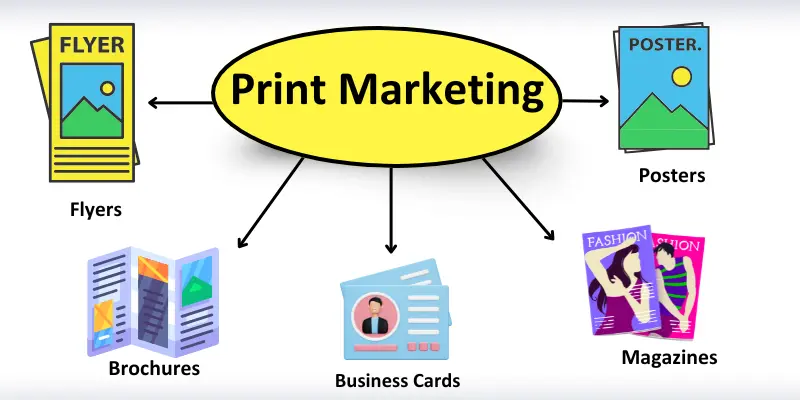Print Marketing – An Overview
Published: 24 Sep 2025
Are you confused about whether print marketing still works in the age of social media and digital ads? Many people think it’s old-fashioned, but the truth is that print marketing is still one of the most trusted ways for businesses to connect with customers and leave a lasting impression. If you want to learn more about traditional types, check out this detailed guide on types of traditional marketing.

What is Print Marketing?
Print marketing is a traditional marketing approach that enables businesses to promote their products or services using printed materials. It includes items such as brochures, flyers, posters, and business cards. Companies create these materials to share information with their audience. Print marketing helps people see and remember a brand. Even in a digital world, it is still a powerful and trusted marketing method.
History of print Marketing
The history of print marketing dates back a long time. In 1450, Johannes Gutenberg invented the printing press. This made printing books and papers easy. People used printed papers to share news and messages. In the 1700s, newspapers became very popular. Businesses saw that printed papers could help them tell people about their products.
In the 1900s, companies began using flyers, posters, and magazines for marketing purposes. These materials helped businesses reach more people. Today, modern brochures, catalogs, and direct mail are used to attract customers. Over time, print marketing has changed a lot. It became faster, more colorful, and more creative. Even with digital ads everywhere, print marketing remains an essential component.
Types of Print Marketing
There are many types of print marketing. Each type helps businesses share their message with people in a simple and clear way.
- Brochures: Small booklets that show products or services.
- Flyers: Single sheets with information about offers or events.
- Business Cards: Cards with contact details for easy communication.
- Posters: Large prints to catch attention in public places.
- Banners: Big signs used for events or promotions.
- Catalogs: Books showing all the products a company sells.
- Magazines: Printed publications with articles and ads.
- Direct Mail: Letters or postcards sent to people’s homes.
- Print Ads in Newspapers: Short ads in newspapers to reach local audiences.
Advantages and Disadvantages of Print Marketing
Like every method, print marketing has good sides and weak sides. It helps businesses in many ways, but it also has some limits.
| Advantages of Print Marketing |
|---|
|
| Disadvantages of Print Marketing |
|---|
|
Real-Life Print Marketing Examples
Examples help us understand better. Let’s see how some famous brands used print marketing.
- Nike – “Just Do It” Posters: Nike printed posters with short and strong words. These posters told people to take action.
- Coca-Cola – Family Ads: Coca-Cola showed families drinking Coke in their ads. These ads made people feel happy and close.
- McDonald’s – Fries as the “M”: McDonald’s used French fries to make the letter “M” in their ads. The design was simple but very smart.
Conclusion
So, friends, it’s time to wrap up! We have discussed print marketing in detail. I recommend using print marketing if you want people to remember your brand in a simple way. Try brochures, flyers, or posters for your next campaign. Start today and see how print marketing helps your business grow.
Common Queries about print marketing
Here you can find answers to popular questions about print marketing
It means using printed papers or designs to promote products. People see these in newspapers, flyers, or brochures. It is one of the oldest ways to market a business.
Print marketing is effective because people can see, touch, and keep printed items. It feels more personal and real compared to online ads. It also builds strong trust and leaves a lasting memory.
A print ad model is the design plan for creating a printed advertisement. It shows how text, images, and colors will appear on the paper. This model helps make the ad clear, creative, and eye-catching.
Print marketing uses physical materials like posters, brochures, and magazines. Digital marketing uses online tools like websites, social media, and emails. The main difference is that print is offline, while digital is online.
Printed marketing materials are physical items that businesses use to promote their products or services. These include things like flyers, brochures, business cards, posters, and catalogs. They help people remember the brand because they can hold and see the materials in real life
The future of print marketing is still strong. Businesses will continue to use it along with digital marketing. Together, they can reach more people.
Shops, restaurants, schools, and local businesses use print marketing a lot. They find it easy to reach nearby people. Even big brands use it for building trust.
Yes, it is perfect for local businesses. Flyers, posters, and banners can attract people nearby. It works well for shops, restaurants, and services in one area.
Avoid too many words and small text. Do not use poor-quality paper or blurry images. Keep it clean and simple.
Sometimes print marketing can be costly because printing needs paper, ink, and design. But small items like flyers or business cards are affordable. The cost depends on how much you print.

- Be Respectful
- Stay Relevant
- Stay Positive
- True Feedback
- Encourage Discussion
- Avoid Spamming
- No Fake News
- Don't Copy-Paste
- No Personal Attacks

- Be Respectful
- Stay Relevant
- Stay Positive
- True Feedback
- Encourage Discussion
- Avoid Spamming
- No Fake News
- Don't Copy-Paste
- No Personal Attacks
